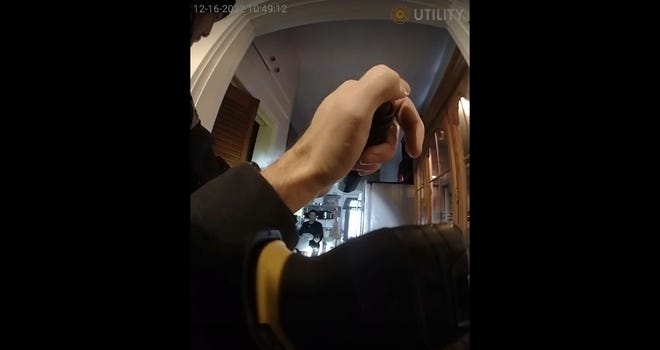EVANSVILLE — Mauricio Cisneros live-streamed 54 seconds of his last moments alive on Facebook — the rest are captured on Evansville police body cam footage.
The 47-year-old Evansville man was shot and killed by an EPD officer Friday morning, after the agency responded to his home in the 1300 block of North Third Avenue for a 911 hang-up. EPD has not released the name of the officer.
The start of Cisneros’ own short Facebook video can be pinpointed in body cam footage released by EPD. The videos come from two officers – the officer who initially responded to the call and a second who comes in later.
According to EPD Spokeswoman Sgt. Anna Gray, both of those officers were trained in crisis intervention, a 40-hour course.
More:Coroner IDs man killed by police amid mental health ‘episode’
Between the two, they had more than 200 CIT reports in EPD’s system.
The vision statement for CIT Indiana states, “a person experiencing a mental health and/or substance use disorder crisis will receive a safe and empathetic response and access to care with a focus on recovery.”
The Facebook live
In Cisneros’ Facebook live, the phone is pointed mostly at the floor, but the first arriving EPD officer can be seen in the doorway and heard speaking. About five minutes into that officer’s bodycam footage, Cisneros video begins.
The Courier & Press asked Gray about Cisneros’ Facebook video Tuesday afternoon. She said it was the first she’d heard of the video, but that detectives may know about it.
“I’m sure that’s probably something, if that was the case, in the investigation (that) will be certainly be looked into for sure,” she said. “Detectives are are still looking at all aspects of that. Certainly the phone is something they would look into.”
From Cisneros’ point of view, viewers can see, and hear, a portion of the conversation where he appears to ask for an ambulance. The first officer continues to speak with him, asking why he needs the ambulance.
“I’m scared right now,” Cisneros said.

The conversation continues on Cisneros’ video for about 30 more seconds. The second officer arrives in the doorway almost immediately after Cisneros ends his video.
Via bodycam footage, the first officer on scene can be heard telling the arriving officer that the man, whose name they did not know at the time, has a knife in his right hand, appears to be schizophrenic and might be having “an episode.”
“He sees people that aren’t here,” the first officer says.
“Do you want me to go less lethal,” the second officer asks, removing his Taser from his belt.
“Yeah, if you don’t mind,” the first says back.
Less than 15 seconds later, Cisneros appears to stand up, and the second officer discharges his Taser – causing the man to yell in pain, shake violently and move into the corner of the room.
More:27 years after disappearance, police to send items in Heather Teague case for DNA testing
The officer who fired the Taser then approaches Cisneros, who by then was moving erratically on the floor. While the Taser appears to still be dispensing an electrical charge, Cisneros continues to move erratically while holding the blanket police previously said he used to conceal the knife.
Seconds later, an officer fires multiple shots and Cisneros drops to the floor. The EPD did not disclose which officer fired their weapon.
Language barrier
Throughout the videos of the incident, Cisneros appears to switch between both English and Spanish. He did the same on the 911 call.
In the 911 call, which lasts around one minute and 20 seconds, the dispatcher asks Cisneros to repeat himself or tells him they do not understand at least six times.
“Sir, listen to me. You’re talking so fast, and I’m having a hard time understanding your accent,” the dispatcher says about halfway through the call. “What’s the emergency there?”
Gray said dispatchers may call for an officer who is bilingual if anyone is available in a situation like this. Otherwise officers will rely on making a phone call or something like it, she said. If a translator would be brought to a scene, it would have to be cleared before they could enter.
In this instance, the run card does not show a dispatcher requesting a bilingual officer. But the notes state the man is difficult to understand.
Even if a bilingual officer was requested, it would be hard for EPD to guarantee the availability of one.
Gray didn’t know the exact number of officers who were bilingual on the department, but said “it’s a very low number.”
“A handful,” she said. “If that.”
The same was said for officers who know some basic Spanish, such as commands, or can understand some when it’s spoken to them.
“That number would be a handful or a little more,” she said.
The Courier & Press reported last year that Vanderburgh County’s count of Hispanic or Latino residents rose 63% to just over 6,300 — making up 3.5% of the county population in the 2020 Census. In the city, 4.3% reported they are Hispanic or Latino.
During his seven minute conversation with Cisneros, the first officer said he could not understand him, in multiple ways, at least seven times.
“I can’t understand what you’re saying,” the officer said about a minute and half into their interaction.
Cisneros appears to ask if someone speaks Spanish.
“No, I’m speaking English,” the officer responds. “I’m sorry.”



